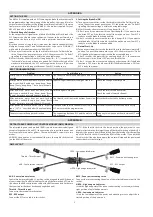
USING THE VG SYSTEM
The Combat VG system uses a reduction system of pulleys between the central part of the crossbar and the hang
point tower channel to enable a wide VG range. The change in airframe nose angle from VG loose to tight is over 2
degrees. Tightening the VG increases the spanwise tension which the airframe places on the sail, reducing the spanwise
twist and the sail elasticity. The result is an increase in L/D performance and a reduction in roll control authority and roll
control response.
The VG is activated by pulling on the VG rope and then moving the rope to set the rope in the cleat. The
recommended procedure for increasing VG tension is to grasp the rope firmly at the cleat, and pull straight along the
basebar.
VG full loose is for maximizing roll control authority and roll rate.
Between VG full loose and VG one half, the glider retains good lateral control authority and response.
Tighter than VG one half, the glider’s roll pressures increase significantly and the roll rate becomes significantly
slower. Tight VG settings are recommended for straight line gliding, or for flying in smoother conditions when well clear of
both the terrain and of other gliders. The stall characteristics of the Combat at tighter VG settings are more abrupt and
less forgiving and the glider is more susceptible to spinning. Full breaking stalls and accelerated stalls at tighter VG
settings are not recommended.
LANDING THE COMBAT
Under ideal conditions, landing approaches are best done so as to include a long straight final into the wind at a
speed above best L/D speed. In a very limited field, or a field which slopes slightly downhill, when landing in light wind,
you may need to make your final approach at a slower speed, perhaps as slow as minimum sink, in order to be able to
land within the field.
In winds of less than 5 km/h (3 mph), if the landing area slopes down hill at more than 10:1, you should seriously
consider landing downwind and uphill; or crosswind, across the slope. Landing attempts, which require slow speed
approaches, maneuvering around obstacles or into a restricted area, or downwind or crosswind landings are not
recommended for pilots below an advanced skill level.
We recommend that you make your approach with the VG set between full loose and 1/2 on. A full loose VG setting
will reduce glide performance, making it easier to land on a target or within a small field. It will also ensure maximum
control authority during the approach, and especially when flying very slowly on final. At VG full loose, however, there is
some loss of aerodynamic efficiency and flare authority, For this reason, in very light winds, at higher wing loadings or at
higher density altitudes, it is recommended that a setting of VG 1/3 – 1/2 ore more be used. A full loose VG setting will
also increase the glider’s roll sensitivity, and some pilots have had difficulty with roll / yaw oscillations on final. The best
way to avoid this is to fly your entire approach at a constant airspeed, and to control your touchdown point by making
adjustments to the shape of your pattern. You
should choose your approach speed based on the amount of wind and
turbulence present - in stronger wind and more turbulent air, fly faster. In any case, however, try to fly a constant airspeed
throughout the approach.
Once established on a straight final approach, with wings level and flying directly into the wind, you should fly the
glider down to where the basetube is between 1 and 2 m (3-6 ft) off the ground. At this altitude, let the control bar out just
enough to “round out” so that your descent is arrested and your flight path parallels the ground. The remainder of your
approach will consist of bleeding off excess speed while paralleling the ground and keeping the wings level and the nose
pointed in your direction of flight until it is time to “flare” for landing.
Fig. 22
Prior to the landing flare your body position should be
generally upright, but slightly inclined forward, with your
head and shoulders forward of your hips and your legs and
feet trailing slightly behind.
Many pilots make the mistake of trying to get too
upright at this stage of the landing, which actually reduces
your flare authority and makes it harder to land on your
feet. Your hands should be at shoulder width and shoulder
height on the uprights (
Fig.22)
.
You should be relaxed, with a light grip on the bar, and
your weight should be fully supported in your harness and
not at all by your arms. (If your harness does not allow you
to hang in the proper semi-upright landing position “hands
off,” without supporting your weight on the control bar, you
will have a lot more difficulty making good landings).
We wish you many happy landings!
14
















































